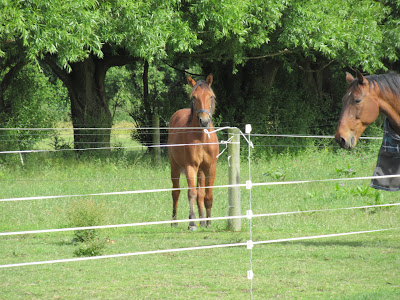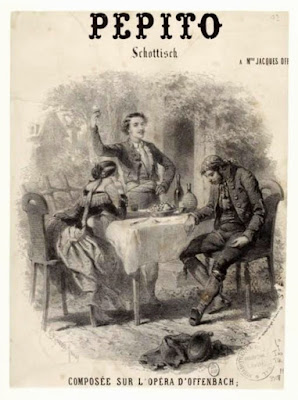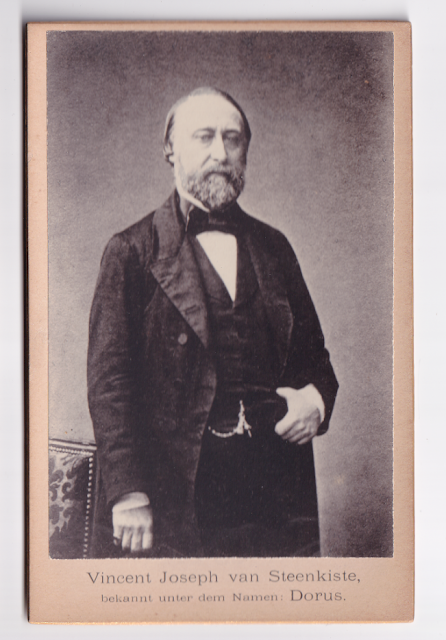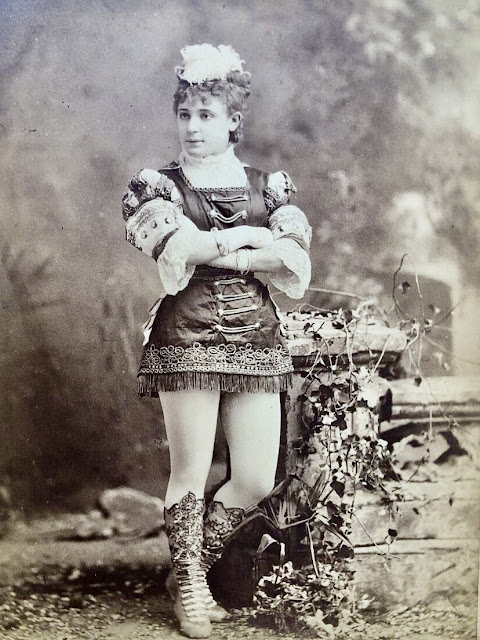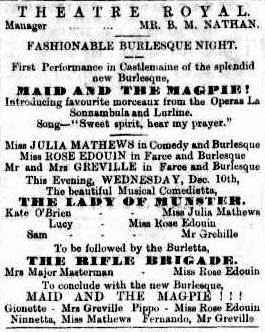This photo came up on my screen today when I was busy reviewing a new book on Offenbach. The back of the picture says just "Wyndham", but the vendor avers that it is the singer Fanny Wyndham. It looks like her ... 1860s? She'd have been fortyish ...
 |
| Fanny Wyndham |
Then I remembered that years ago I had written a piece on Fanny for my Victorian Vocalists, and not used it ... so here it is ..
WYNDHAM, Fanny (Madame Frédéric LABLACHE) [WILTON, Mary Anne Frances Charlotte] (b Edinburgh, ?c1821 ?1816?; d Paris, 23 September 1877)
Miss Fanny Wyndham promised great things. There were some who claimed her – in her time, and even after – as one of the greatest British contraltos of the 1830s, some who spoke of her in the same breath as Mrs Alfred Shaw or Charlotte Dolby. But marriage, children, intermittent ill-health and, perhaps, a lack of ambition combined to make what might have been a magnificent career into a more comfortably modest one.
Fanny Wyndham and her elder sister, Mary Ann, known simply as Miss Wyndham, were the daughters of Mr William Nicholls Wilton (b Westminster 6 October 1777), wine merchant, and, following the fashion of the time, when they took to the stage, they adopted an aristocratic nom de théâtre. Since the sisters were born in Edinburgh, their birth-dates and circumstances remain a mystery to me ('sources' claim 1821), and the first time ‘Miss Wyndham’ appears to my gaze is in 1832, when the Morning Chronicle reports ‘a young lady named Wyndham has been playing Helen in The Hunchback at Cheltenham with great success’. In October that same year, the Misses Wyndham can be seen in the company at the Theatre Royal, Edinburgh (‘The Misses Wyndham are prepossessing ladies – commanding in figure and pleasing, perhaps pretty, in countenance ...’) and what looks like Miss E Wyndham is playing Rosara in the musical melodrama The Broken Sword. The following 1 March 1833, I see them taking a Benefit at the Theatre Royal, Aberdeen in which Mary Ann played The Belle’s Stratagem and Fanny Perfection: ‘we were highly gratified with Miss Fanny Wyndham’s ‘Kate O’Brien’ for she performed the part with infinite archness and grace. Her singing, too, was admirable. The sweetness and feeling with which she sang ‘Bonny Mary Hay’ we have seldom heard equalled’. Could she really have been twelve years old? I think not. I think Fanny may have chopped 5 years off her age .. when she married, she said she was of full age
Later that year, the sisters went their separate ways, Mary Ann to Hull where she played Lady Teazle one minute and Meg Merrilees the next, and replaced Mary Cawse in a singing role with considerable success. Of Fanny, the press reported ‘she is we hear a vocalist of considerable talent and acquirements, a pupil of the celebrated Barnet (sic), and some months back made a great impression at York where she sang at the Theatre Royal several nights’.
Miss Wyndham seems to have played several seasons at Hull, and on the occasion of her Benefit 3 March 1835, she introduced her sister ‘Miss Fanny Wyndham, her first and only appearance here’. Fanny played Perfection and Caroline Grantley in Vestris’s vehicle Beulah Spa, sang ‘Why did I love?’ and ‘Pretty star of the night’ and joined Mary Ann Atkinson in duet: ‘She is possessed of a voice of peculiar sweetness and sings with great taste and judgement. Besides several ballads introduced incidentally Miss F Wyndham took part in Rossini’s splendid duet ‘Giorno d’orrore’ with Miss Atkinson and acquitted herself in such a manner as to give a most favourable impression of her capabilities in the higher order of vocal composition. In the very laughable farce of Beulah Spa Miss F W personated three characters and proved that her talents are not confined to music alone… she is hired for the last three nights of the season’.
During those extra nights she repeated her playlets and appeared in The Loan of a Lover and Black-Eyed Susan.
Fanny (‘from the King’s Concerts’) returned to York (Beulah Spa, Married Life, Past Ten o’clock, Paul Pry, Clari, Turn Out) and later in 1835, the sisters played at the Theatre Royal, Bristol, where ‘Miss F Wyndham from the Theatre Royal York’ made her first appearance as Ophelia to the Hamlet of Charles Kemble, and went on to play Dolly Mayflower in Black-Eyed Susan, Betty Higgins in The Rake’s Progress, Polly Briggs in The Rent Day etc, whilst her sister favoured the more dramatic roles behind leading lady Mrs D Lee. It was also reported that ‘she has sung at the Cambridge Philharmonic Concerts.’
1836 was a turning point for the Wyndham sisters. Mary Ann was engaged for leading roles at the Theatre Royal, Covent Garden. She debuted as Nina in Born to Good Luck (‘A Miss Wyndham from Edinburgh looked, played and danced Nina with beauty and spirit and is in our opinion a very acceptable addition to the company here’) and she would go on there to a satisfying career until, in 1838 (1 May), she became the wife of one Mr Florent Henry, teacher, and left the stage.
Fanny went back to school. To the Royal Academy of Music. She did not, however, give up performing, but her engagements were initially more vocal than theatrical. In April she ‘made a debut’ at the Academy concerts (‘pupil of Signor Crivelli’), alongside the British premiere of the Choral Symphony, and was lauded for ‘a remarkably fine voice of great compass, fullness and sweetness; and there is a refinement and delicacy in her execution which prove that she is a singer of impulse and not a mere automaton’. She gave the Semiramide duet with a Mrs Smith: ’These two ladies are a valuable acquisition to the list of English singers’. Amongst the supporting soloists was the 14 year-old ‘Miss Dolby’.
In July, I spot her singing under Rudersdorff at the Yorkshire Amateur Concerts (Horn’s ‘Through the wood’, ‘Se m’abbandoni’, ‘Auld Robin Gray’), and in December at Mr Harper’s concerts in London and at Doncaster.
In December 1836, Signor Puzzi and Mr Mitchell mounted a company to play Italian Opera Buffa at the Lyceum Theatre. The artists engaged were almost all Italians, but two young Englishwomen, Miss Glossop and Miss Fanny Wyndham, were cast in Un Avventura di Scaramuccia (29 December 1836). The result was striking: ‘Miss F Wyndham made her first appearance on any stage’, reported The Times, ‘she sings with exquisite taste; her voice is a fine contralto, and we have no doubt that she will prove a great acquisition to the theatre.’
Fanny – while still a student -- went on to sing Princess Euphemia in Chiara di Rosembergh (24 January 1837), Cherubino in Le Nozze di Figaro and Giannetto in Benedict’s Un anno e un giorno (‘loudly encored’) with Mme E Giannoni and Sebastiano Ronconi. But there was more to come. When the opera buffa season ended in mid-February, Miss Fanny Wyndham moved across directly to the King’s Theatre, London’s Italian opera house.
She made here first appearance there on 4 March 1837, in the role of Malcolm in La Donna del lago and – in a production elsewhere seriously undercast -- The Times was delighted with her, ‘we never heard her, whatever the cause, produce so much effect or sing so well. The music suited her and she was at home in it’. The same he could, and did, not say for the new soprano de Angioli nor the tenor Deval.
22 April La gazza ladra was produced, and Fanny was cast for Pippo, which in the theatre’s previous performances had been sung by … a bass. Her lively acting irritated the Examiner’s lofty critic ‘a young lady we believe from Lord Burghersh’s collection at the Royal Academy. Miss Wyndham has a tolerable contralto voice which is generally in tune but over which she has very little command ... Without one spark of naievete this young lady ambled and wheeled and turned about and jumped Jim Crow throughout the opera in so provoking a manner that we wished her not at Hanover but safe back in Hanover Square...’ He also criticised Grisi’s Ninetta and thoroughly rubbished Ivanhoff and Albertazzi.
Later in the season, she played Agnese in Malek Adel.
Her operatic engagements did not get in the way of Fanny’s concert singing, and she was seen liberally through 1837 both in the concerts of the RAM, and in London and the provinces. She went to Bath for Loder, visited the Yorkshire meeting again ‘Miss Fanny Wyndham of the Italian opera’ (alongside ‘Mlle Rudersdorff of the Paris Conservatoire’), and also made an appearance in Manchester (‘a rich contralto voice of good quality and compass her execution is very respectable’) before, come December, she returned briefly to the opera buffa company to repeat her Scaramuccia, The prima donna contralto of the company, however, was Mme Eckerlin who sang Rosina when Il Barbiere di Siviglia came round. And Fanny, it appears, was not quite comfortable on stage. ‘She more than once on this occasion reminded us of Albertazzi; but can an English singer never move about the stage as if actuated by some impulse connected with the same? It would seem not’, wrote one paper after a performance at the Opera Buffa.
Her 1838 concert season was her fullest yet. She began the year at Signor Puzzi’s Classical concerts, in Bath and London, in which many of the artists of the opera buffa company appeared. Fanny sang Mozart’s ‘L’Addio’, by far her most frequent choice as a concert item at this time, and duetted ‘Crudel perche’ with Frédéric Lablache. They would still be singing it together, as a long married couple, twenty years down the track.
She sang at Drury Lane on King Charles the Martyr night (‘Miss Fanny Wyndham’s songs were the best performances of the evening...’), at Mori and Lindley’s concerts, at the Society of British Musicians, at more Puzzi concerts (‘Miss Wyndham has considerable talent natural and acquired and continues to rise in public estimation’), at the Olympic Theatre in The Creation, at the Societa Armonica, duetting Tancredi with Persiani and ‘Mira la bianca luna’ with Ivanhoff, at Moscheles’ concerts, the Ancient Concert (‘Che faro’), for Mme Dulcken, Agosto Sagarini, Miss Pritchard of Bath and others, but in early May she headed north to Edinburgh, where Mr Mitchell had taken his opera buffa company, to play Scaramuccia opposite the young Lablache. ‘Her success was as complete as that of the other performers who preceded her on Tuesday…she has a voice of the contralto species not very powerful but of liquid sweetness and uncommon flexibility... she sings with great delicacy of expression and executes her florid passages with great neatness and facility..’, ‘quiet dignity’. This time, when they did Il Barbiere, it was Fanny who sang Rosina, and when the company moved on to Manchester she sang Countess Almaviva in Le Nozze di Figaro.
In July, she took part with other Royal Academy pupils in a performance of Lord Burghersh’s Il Torneo at the St James’s Theatre, and in November and December sang the principal contralto music in Samson and The Messiah with the Sacred Harmonic Society.
Miss Wyndham was at the peak of her powers, and when she visited the Liverpool Amphitheatre the local critic raved ‘There is not another living songster that we have heard who possesses a more beautiful and more perfect range of voice than Miss Fanny Wyndham. From the highest to the lowest every note is mellifluous. There is only one thing wanted to make her the finest living singer but we fear that Miss Wyndham cannot accomplish it. She always sings in medium and piano tones, but does not put forth her forte ... ‘. She gave, as ever, ‘L’Addio’ and ‘John Anderson, my jo’ an example of the Scottish songs which would become her trademark in later years.
In the first part of 1839, Miss Fanny Wyndham was heard everywhere. At Exeter Hall with the Sacred Harmonic Society (Israel in Egypt, Joshua, The Messiah ‘it is impossible to bestow higher praise’, Dettingen Te Deum), at the Hanover Square Rooms in from Blagrove, for Mrs Dulcken, for G A Kollmann, at the concert room of Her Majesty’s Theatre, with the Societa Armonica (‘Io l’odio’, Himmel’s Battle Hymn, Or la sull’onda (Il Giuramento), Kalliwoda’s ‘The Grave Digger’), for the harpist Labarre, for Julius Benedict (22 May) and for the concert of Signor F Lablache (24 May), and on the theatre’s stage at the concerts of Mori, at the Haymarket Theatre for William Kenneth’s Benefit, at Willis’s Rooms for the Northern Dispensary, Madame Sala, Mlle Sedlatzek and Signor Brizzi, at Store Street for Miss Steele, at the Foundling Hospital Chapel, the concerts of Ancient Music, the Royal Society of Musicians annual Messiahsharing the contralto music with Maria Hawes and Mrs Toulmin, at the Hanover Square Rooms for Chatterton and Card (21 June), for Thalberg (24 June) and for Mons Hauman (1 July), at the English Opera House in Stretton and Giubilei’s Benefit (28 June).
And then it stopped. For in July 1839 Miss Fanny Wyndham became Madame Frédéric Lablache. But, in spite of the say-so of the Dictionary of National Biography and all other sources from which it has copied, or which have copied from it, she certainly did not retire from performing.
Fanny Lablache returned to the concert platform in February 1840 – she had, it was said, been ill -- and during the month was heard at the Quartet Concerts, at Thalberg and Benedict’s concert, at Mr Ransford’s, at Allcroft’s at the Haymarket Theatre, at Mr Marshall’s at Oxford, and in a private soirée for the Queen Dowager. Most often, the two Lablaches appeared together, inevitably with a duet (‘Senza tanti complimenti’ (Il Burgomestro), ‘Les muletiers’) sometimes with an aria apiece, and Fanny – who usually took a smaller part in the proceedings – with a Scottish song.

However, she had barely begun again when – in a manner which would characterise her later career – she stopped again. This time, it was a child, Therese Francesca Lablache, born in Westminster 13 May 1840. It is December 1840 before I spot her back at Exeter Hall, singing with the Sacred Harmonic Society, and in the new year she once again picked up the concert trail, for the season. A concert for the Hull Choral Society typified a Lablache bill, Fanny’s contribution was one aria -- -- ‘Or la sull’ onda’ again, one ballad, Parry’s ‘The days of yore’, ‘Logie of Buchan’ and ‘Dunque io son’ with her husband. On 16 June 1841, her husband gave his concert at Her Majesty’s Theatre and – alongside Grisi, Mario, Viardot Garcia, Dorus Gras and the other stars of the place -- Fanny gave her faithful ‘L’Addio’.
The Lablaches spent the latter part of 1841 and into 1842 in Paris, where Frédéric made his début at the Théâtre des Italiens as Figaro (‘un gros et grand garcon de bonne mine .. un baryton d’un assez beau timbre et volume suffisant .. comme acteur convenable..’), and in Paris Fanny gave birth to her second daughter, Fanny Rose.
The couple returned regularly to London, but in 1842 and 1843 she was rarely seen on the concert platform. It was not until 1844 that the couple set out on a tour of northern England, in conjunction with Henry Russell, The Musical Review reported: ‘Everybody who has ever once had the pleasure to hear this charming vocalist, will be gratified to learn that she has now quite recovered her voice and strength, and will shortly prove that she still possesses the full power and compass of that exquisite organ, which required only to be heard to be acknowledged the finest contralto in existence; her purity of style, beauty of elocution, and correct intonation, have won for her the distinguished position which she has now for some time held in the musical world.’
However, it did not last. Soon it was Signor Lablache alone who was seen out in public. Fanny’s public appearances came thereafter in spurts, and most often in tandem with her husband, in the duet-ballad-Scotch song format which had become their norm. When Fanny appeared – four months after the birth of Luigi Frederick, her third and last child (27 January 1850) -- at Miss Birch’s concert (15 May 1850) at the Hanover Square Rooms the press appreciated her ‘beautiful contralto voice’ in ‘Notte tremenda’ and commented ‘She is too seldom heard’.
In 1853, Fanny fulfilled the fullest season on the concert platform since her marriage, whilst the couple concurrently ran their ‘second series of concerted vocal classes for ladies’ at their home at 149 Albany Street. When she sang the Fioravanti ‘Singing Lesson’ with her husband at Mrs Alexander Newton’s at home (28 June 1853) the press assured that ‘we never heard her to greater perfection’, but it was nevertheless to be a final flash. Thereafter, Fanny’s appearances were rare and well-spaced.
In her retirement, Fanny continued to teach singing. The couple ultimately settled in Paris, and it was there that ‘Fanny Wyndham’ died, after a bathing accident at Boulogne, in September 1877. Maybe or maybe not at 56 years of age.
The children of the Lablaches all had artistic careers, but not in the same world as their parents. Therese married the great German basso Johann (sic) Rokitansky (b Vienna 8 March 1835; d Schloss Laubegg 2 November 1909) (French Chapel Marylebone 8 November 1865), Fanny (d 5 April 1885) made herself a considerable name as an authoress of children’s books, and Luigi (d 51 Albany Street 18 December 1914) and his wife ‘Miss Emerson’ [BREADON, Jane Clementina, d Bournemouth 4 July 1938] had a sufficient career on the non-musical stage. A grandson of Luigi, James Lablache Stewart (1913-1993) continued the family’s show business history as a well-known actor under the name Stewart Granger.
Frédéric Lablache (b 29 August 1815) survived his wife by a decade and died at his home at 51 Albany Street, in London 30 January 1887.



